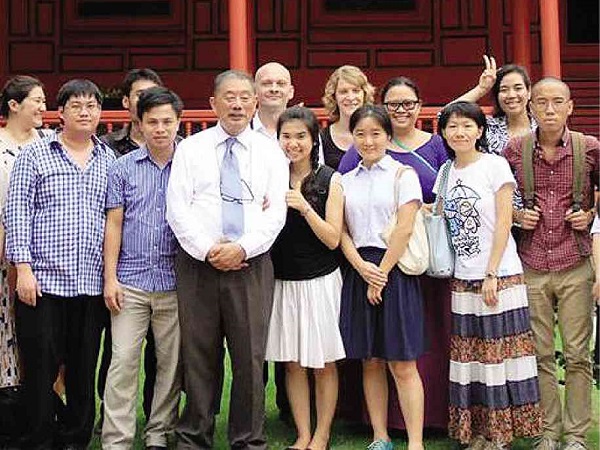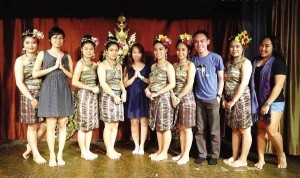Time to think Asean

JUNE TAGUIWALO (second from right, back row), with classmates from Chulalongkorn University. Contributed photo
PHITSANULOK, Thailand–June Taguiwalo was born in a military camp in 1984. At that time, her mother, student activist (now university professor) Judy Taguiwalo, was incarcerated at Camp Crame for resisting the Marcos dictatorship.
Now 29, June is in Thailand, taking her place among a young generation of students who are taking up new challenges in an increasingly globalized world.
Artist Ryan Francis Reyes, 30, is another Filipino student in Thailand, which hosts scholars who are intent on extending their gaze from national to regional horizons–starting with the 10-member Association of Southeast Asian Nations (Asean).
Taguiwalo is currently pursuing a master’s degree in Thai Studies at Chulalongkorn University, the top university in Thailand under the Asean scholarship funded by the government of Thailand. A Geography graduate of the University of the Philippines, she is the only Filipino in the program at the moment. Prior to her Thai studies, she spent two years in Chiang Mai, as a nongovernment organization (NGO) worker.
“I’ve always been interested in Thailand. I think this was the first Asian country I ever visited. We seem so alike but so different at the same time. My interest grew more when I worked in Chiang Mai two years ago,” she explains. Taguiwalo spent her growing up years in Canada while her mother was taking up a master’s degree. She also spent some time in the United States.
Article continues after this advertisement
RYAN REYES (third from right) with cultural performers from hill tribes in Chiang Mai. Contributed photo
Describing her studies at Chulalongkorn University, Taguiwalo says, “Life at Chula is great. The university is so beautiful and the facilities are very modern. My Thai Studies batch is composed of only five students; we’re a very small group. I have classmates from all over the world; many are taking up Asian Studies. We have so many field trips to be able to better understand Thai Culture and religion.”
Article continues after this advertisementReyes, a graduate student of Asian Studies at University of the Philippines and a staffer at UP’s Vargas Museum, is a recipient of a research grant from Southeast Asian Studies Regional Exchange Program (SEASREP) Foundation, an NGO based in Manila that aims to promote academic exchanges among Asean members.
“Most of the researches about Asia and the Asean region in general are from a Western perspective. Hence, I think it is about time that people of Asean should contribute to discourses on Asia, as we know it, as we feel it, and as we see it in the future,” Reyes says.
The Asean community encompasses The Philippines, Thailand, Indonesia, Malaysia, Singapore, Brunei, Burma (Myanmar), Cambodia, Laos, and Vietnam.
Asean community
Thailand, which will be the center of Asean in 2015, is encouraging students from the region to come and study their country.
Taguiwalo says her research plan concerns medical tourism in Thailand–its effect on the local health care system and the current state of Thai healthcare.
“After I finish this study, I plan to do a comparative study between Thailand and the Philippines. The Philippines is trying to break into the medical tourism market, too. I’d like to find out how they plan to do it and at what cost since our local healthcare system is really non-existent,” she explains.
Reyes, on the other hand, is currently doing research on tribal people (the so-called “hill tribes”) as represented in Thai museums, and how this contributes to the Thai identity.
“I decided to do a research about the upland peoples of Thailand for a number of reasons. First, I was fascinated by the fact that these peoples straddle the boundaries of nation-states, which opens up complex discussions on how their identities are being accommodated by various national cultures. Second, I believe that their peripheral positions within national systems make them worthy of attention,” explains Reyes.
Like Taguiwalo, Reyes believes his knowledge of hill tribe cultures and concerns in Thailand will help him better reflect on issues affecting indigenous peoples in the Philippines. “[It] invites reflections on our own national policies” with regards to the tribal peoples and how they influence the crafting of the Filipino national identity.
Having ethnic minorities is also something which many Asean-member states share.
Fostering stronger ties
Thailand will be offering more scholarships in the future.
Taguiwalo says, “My classmates would very much like a Filipino perspective in matters they discuss in class and my Thai Studies department would probably welcome more interest in the field from Filipinos.”
Reyes believes museums are very powerful institutions that can condition the way we think about certain peoples and cultures. Exhibits challenge long-standing stereotypes and perceptions that hinder understanding between people of different cultures.
Reyes thinks that there is an increasing Southeast Asian or regional consciousness among Filipinos nowadays, which is good because Southeast Asia is our immediate community outside the Philippines.
“I encourage Filipinos and other Southeast Asian students to learn more about each other’s history, culture, and society as a step towards fostering a stronger Southeast Asian community,” he ends.
Taguiwalo is expecting to finish her studies in 2015 while Reyes expects to finish his research this year.